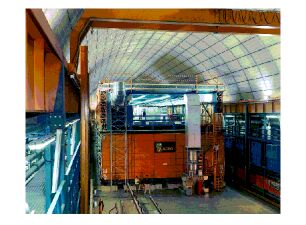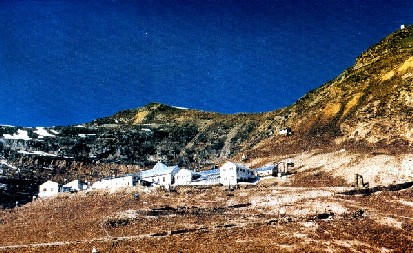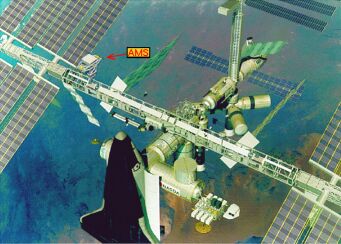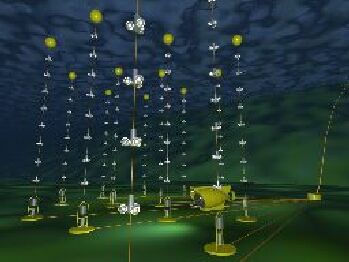Dark matter at the University of Bologna
Research into
dark matter![]() is carried out by the Astronomy and Physics Departments of the University of Bologna, in collaboration with the
Astronomical Observatory of Bologna, national research organisations such as
ASI (the Italian Space Agency ),
CNR (National Research Council) and INFN (National Institute of Nuclear Physics) and international research organisations.
is carried out by the Astronomy and Physics Departments of the University of Bologna, in collaboration with the
Astronomical Observatory of Bologna, national research organisations such as
ASI (the Italian Space Agency ),
CNR (National Research Council) and INFN (National Institute of Nuclear Physics) and international research organisations.
One of the most important
proofs of the presence of dark matter in the spiral galaxies comes from the curves that describe
the rotational speed of galactic matter as a function of the distance from the centre of the galaxy itself
(see movement of stars in a galaxy). The curves are
obtained from observations of spectral lines emitted by ionized gas (Alpha line), by neutral hydrogen gas
(line at 21 cm wavelength) and by molecular gas (CO), measuring the displacement of the frequency of the line (due to the
Doppler effect![]() ).
While the ionized gas and the molecular gas are found in the brighter, central parts of the galaxies,
neutral hydrogen extends well beyond the luminous disk. This allows us to trace the rotation curves at large
distances from the centre of the galaxies.
).
While the ionized gas and the molecular gas are found in the brighter, central parts of the galaxies,
neutral hydrogen extends well beyond the luminous disk. This allows us to trace the rotation curves at large
distances from the centre of the galaxies.
- Rotation curves of spiral galaxies: researchers at the Astronomical Observatory of Bologna, in collaboration with the Kapteyn Astronomical Institute of the Groningen University (Netherlands), have performed research programmes on dark matter in the galaxies for the past thirty years. These programmes are mainly based on observations with the radiotelescopes of Westerbork (Netherlands) and VLA (USA) of the 21cm line of neutral hydrogen in spiral galaxies of various morphological types and various brightnesses. Recent studies have shown that the rotation curve of the spiral galaxy NGC 5055 agrees with the presence of an extensive halo of dark matter.
The search for dark matter of an
elementary particle![]() type can be either direct or indirect. Direct experimental methods
are based on the possible interaction of dark matter particles inside a detector, or which crosses the detector.
Indirect studies try to detect, for example, neutrinos
type can be either direct or indirect. Direct experimental methods
are based on the possible interaction of dark matter particles inside a detector, or which crosses the detector.
Indirect studies try to detect, for example, neutrinos
![]() generated in the decay of hadrons produced in particle-antiparticle
annihilations
generated in the decay of hadrons produced in particle-antiparticle
annihilations![]() (of dark matter) which may occur at the centre of the Earth, the Sun or the Galaxy.
(of dark matter) which may occur at the centre of the Earth, the Sun or the Galaxy.
In addition, experiments with very high energy accelerators are performed to look for new elementary particles
which might make up a part of particle dark matter.
The Physics Department carries out dark matter
research through laboratory experiments without accelerators
(MACRO,
SLIM,
ANTARES and
AMS), and experiments with accelerators
(LEP,
LHC,
Tevatron).
 |
|
|
Fig. 1: Photo of the
MACRO detector. (Credit: MACRO experiment) |
- MACRO (1989 - 2000): this was a large-size detector situated in the underground Gran Sasso laboratories. One of the aims of the experiment was to detect rare events in the penetrating cosmic radiation
Nuclearites would be objects like atomic nuclei, but containing stype quarks
supersymmetric
 Fig. 2: The Cosmic Physics Laboratory of Chacaltaya, La Paz, Bolivia, where the SLIM experiment. (Credit: SLIM experiment) |
|
|
|
|
|
 Fig. 4: The International Space Station (ISS) where the AMS detector will be installed. (Credit: AMS experiment) |
The supersymmetric particles which could make up part of the Universe's dark matter can be investigated with the following accelerator experiments:
- DELPHI, L3 and OPAL (1989 - 2000): These detectors, operating at the CERN LEP collider
- CDF (1989 - ....): CDF is a detector at the Fermilab Tevatron collider in Chicago. The Tevatron accelerates protons and antiprotons up to 1 TeV and then makes them collide at the centre of the CDF detector. Scientists were researching supersymmetric particles and other particles produced in proton-antiproton collisions; these have not yet been found but the research continues with the Tevatron at higher energies and intensities and with an improved CDF detector.
- ZEUS (1998 - ....): Here too, at the DESY laboratory in Hamburg, scientists are searching for many types of new particles produced in positron-proton collisions at high energies. The performance of the collider and of the ZEUS detector have improved.
- ATLAS, CMS and ALICE (2007 - ....): The future experiments ATLAS, CMS and ALICE at the huge new LHC collider at CERN will search for supersymmetric particles and many other possible particles.
A theory group, in collaboration
with a group from the CNR of Bologna involved in the
PLANCK experiment, is studying the implications of dark matter and dark
energy with regard to the results of experiments on the microwave cosmic background radiation and its
anisotropies
![]() .The experiments have provided
detailed images of the Universe when it had a temperature of about 3000 degrees. The ever-improving precision
and resolution with which these anisotropies are detected gives access to primordial information on the dark components of the Universe.
.The experiments have provided
detailed images of the Universe when it had a temperature of about 3000 degrees. The ever-improving precision
and resolution with which these anisotropies are detected gives access to primordial information on the dark components of the Universe.
